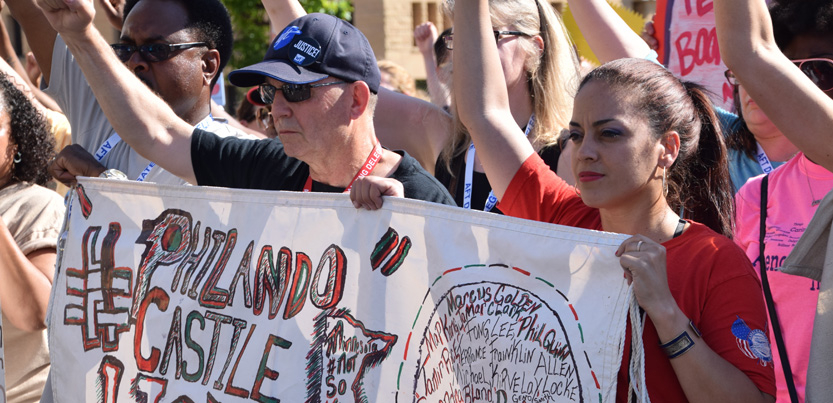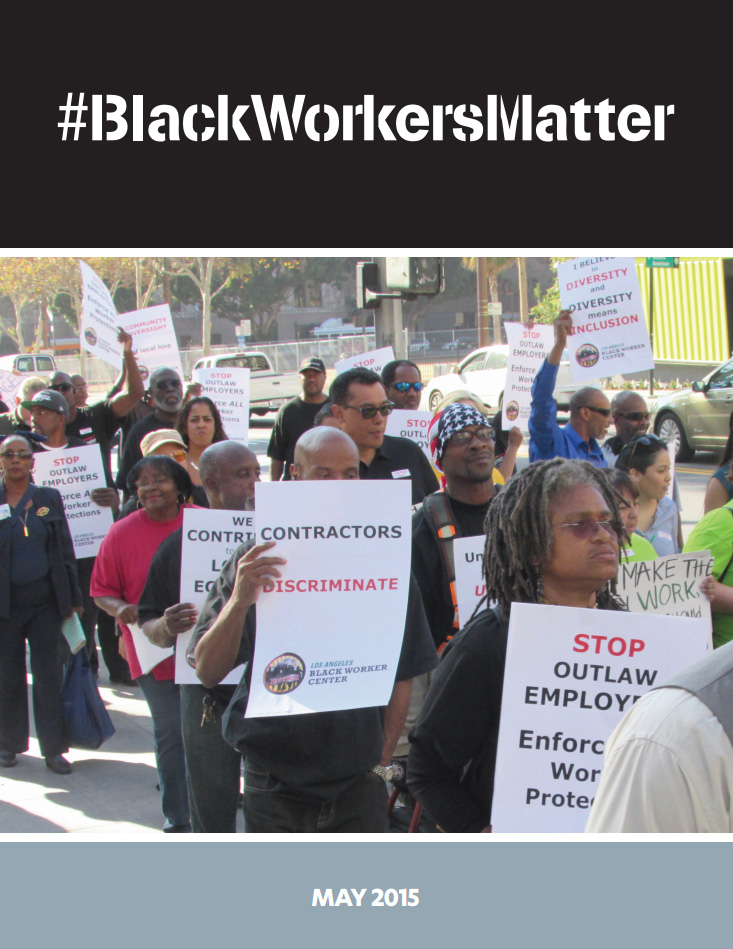Police Violence Is a Labor Issue Too

We can start by supporting the Black Lives Matter movement in our own backyards. Teachers in Minneapolis were arrested in civil disobedience over Philando Castile's death. Photo: Samantha Winslow
After the latest fatal police shootings of Black men, captured in horrifying video footage, many of us are asking ourselves tough questions.
How can we step up to stop this state violence? What can we do to expose and challenge racism against Black people in our own workplaces, communities, and families?
In the August issue of Labor Notes, we highlight how rank-and-file members are getting involved through their unions to try and answer some of these questions, and to support the Black Lives Matter movement.
What does police brutality have to do with labor? For one thing, over-policing is connected to poverty wages.
#BlackWorkersMatter

The #BlackWorkersMatter report is a good resource for in-depth context on the Black jobs crisis. It profiles innovative Black worker organizing across the country.
Black workers face double the unemployment rate that white workers do. Nationally, 38.1 percent of Black workers earn sub-poverty wages, compared to 25.9 percent of white workers.
The disparities are even greater for Black women and for young Black workers.
As a labor movement, we haven’t been able to dismantle these inequalities. But as union density shrinks, the problem only gets worse.
It’s Black workers who have been pushed out of union jobs the fastest. Between 1983 and 2007, the percentage of Black workers who have a union dropped by 16 percent—compared with only 9 percent for white workers.
When low-wage jobs and part-time hours are the only options on offer, people are often forced into the informal economy—for instance, selling CDs on the street, as Alton Sterling was in Baton Rouge when he was killed.
Then, as Todd Cherkis of United Workers in Baltimore reminded us last year, “it’s the police who are tasked with keeping the unjust order in place, harassing and arresting people for subsistence crimes—without offering them a viable alternative.”

SUPPORT LABOR NOTES
BECOME A MONTHLY DONOR
Give $10 a month or more and get our "Fight the Boss, Build the Union" T-shirt.
The crisis facing many low-wage Black communities should be a warning to non-Black workers, too, says Lola Smallwood Cuevas of the L.A. Black Workers Center.
“When you want to see failure in the economy, you just need to drive down Vermont or Crenshaw Boulevard [in Los Angeles], and you can see the starkest example of what happens when you disinvest in working-class communities, when you deregulate, when you de-unionize,” she said.
In Labor Notes we’ve shared stories of union members who believe racial justice is just as important as wages and job security—both in their contract negotiations and in their community work. But we need more of these examples.
When unions don’t fight on issues that affect their members' lives—from immigration detention and deportation, to over-policing and mass incarceration—we lose the chance to build powerful alliances, and to be seen by members as a relevant source of power to fight and win.
History has shown us time and time again that when the labor movement buys into the politics of division and exclusion, our entire movement is weaker for it.
START WHERE YOU CAN
How do we build upon the shock and anger many people are feeling right now, the sense that we can no longer turn away?
Labor activists—in unions and worker centers alike—are in a unique place to build bridges between the workplace and our communities. Our organizations include members of different races who have different experiences and perhaps different views—but who already have something in common. There’s an opening you might not have with a stranger.
In a workshop at AFSCME Local 3299, when members shared stories of violence they or family members had experienced personally, “you could have heard a pin drop in the room,” said Luster Howard, a truck driver who spearheaded forming the local’s Racial Justice Working Group. “This isn’t somebody on the news… It’s happening in your backyard. It’s a little different when it’s your [union] brother or sister.”
And unions and worker centers are established organizations with local credibility and some material resources—money, meeting space, media lists, member lists, connections with other organizations, sometimes even the ear of local politicians. We can share these resources with an emerging movement.
It’s never been more urgent to start, wherever we can.






